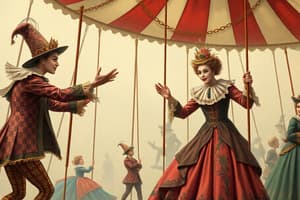Podcast
Questions and Answers
What is the origin of the clown character?
What is the origin of the clown character?
- Fifth Dynasty of Egypt
- Commedia dell'arte (correct)
- Native American cultures
- Ancient Greek and Roman theatre
What is the name of the individual in Lakota and Dakota culture who lives outside the constraints of normal cultural roles, playing the role of a backwards clown by doing everything in reverse?
What is the name of the individual in Lakota and Dakota culture who lives outside the constraints of normal cultural roles, playing the role of a backwards clown by doing everything in reverse?
- Pierrot
- Heyoka (correct)
- Auguste
- Harlequin
Which clown character is typically associated with children's entertainment?
Which clown character is typically associated with children's entertainment?
- Harlequin
- Bozo-derived (correct)
- Pierrot
- Auguste
What is the name of the Canadian clowning method that combines European and Native American clowning techniques?
What is the name of the Canadian clowning method that combines European and Native American clowning techniques?
What is the name of the British clowning organization responsible for the Clown Egg Register?
What is the name of the British clowning organization responsible for the Clown Egg Register?
What is the most prevalent character clown in the American circus?
What is the most prevalent character clown in the American circus?
What are frameworks and shows in clowning?
What are frameworks and shows in clowning?
What is the name of the clowning organization for clowns, jugglers, magicians, and face painters in America?
What is the name of the clowning organization for clowns, jugglers, magicians, and face painters in America?
What is the purpose of hospital clowning in children's hospitals?
What is the purpose of hospital clowning in children's hospitals?
Flashcards are hidden until you start studying
Study Notes
A Brief History of Clowns
-
The most ancient clowns have been found in the Fifth Dynasty of Egypt, around 2400 BC.
-
Clowning is often considered an important part of training as a physical performance discipline.
-
In anthropology, the term clown has been extended to comparable jester or fool characters in non-Western cultures.
-
Heyoka is an individual in Lakota and Dakota culture cultures who lives outside the constraints of normal cultural roles, playing the role of a backwards clown by doing everything in reverse.
-
The Canadian clowning method developed by Richard Pochinko and furthered by his former apprentice, Sue Morrison, combines European and Native American clowning techniques.
-
The first mainstream clown role was portrayed by Joseph Grimaldi, who also created the traditional whiteface make-up design.
-
The comedy that clowns perform is usually in the role of a fool whose everyday actions and tasks become extraordinary.
-
The clown character developed out of the zanni rustic fool characters of the early modern commedia dell'arte, which were themselves directly based on the rustic fool characters of ancient Greek and Roman theatre.
-
The circus clown developed in the 19th century.
-
The strong association of the (Bozo-derived) clown character with children's entertainment as it has developed since the 1960s also gave rise to Clown Care or hospital clowning in children's hospitals by the mid-1980s.
-
There are different types of clowns portrayed around the world, including circus, Pierrot and Harlequin, white and Auguste, and scary and evil.
-
The character clown adopts an eccentric character of some type, such as a butcher, a baker, a policeman, a housewife, or hobo.Overview of Clowning
-
Famous character clowns include Lloyd, Buster Keaton, Charlie Chaplin, Rowan Atkinson, and Sacha Baron Cohen.
-
Character clown makeup typically starts with a flesh tone base and may use accessories like glasses, mustaches, warts, big ears, and strange haircuts.
-
The most prevalent character clown in the American circus is the hobo, tramp, or bum clown, with subtle differences in attitude.
-
The World Clown Association and Clowns of America International are organizations for clowns, jugglers, magicians, and face painters.
-
Clowns International is a British clowning organization responsible for the Clown Egg Register.
-
Clowns may perform other circus roles or skills like tightrope, juggling, unicycling, and Master of Ceremonies, or sit in with the orchestra.
-
Frameworks are the general outline of an act that clowns use to build out an act, and shows are the overall production that a clown is a part of.
-
Clown stops or interludes are brief appearances of clowns in a circus while the props and rigging are changed and typically involve a few gags or several bits.
-
Among the more well-known clown stunts are the squirting flower, the too-many-clowns-coming-out-of-a-tiny-car stunt, and prop stunts.
-
The clowning is a thread that links the whole show together in many modern circus shows.
-
The clowning industry is a serious business and clowns may be required to attend formal training and workshops.
-
Clowning can be therapeutic and is used in hospitals to help patients cope with their illnesses.
Studying That Suits You
Use AI to generate personalized quizzes and flashcards to suit your learning preferences.




